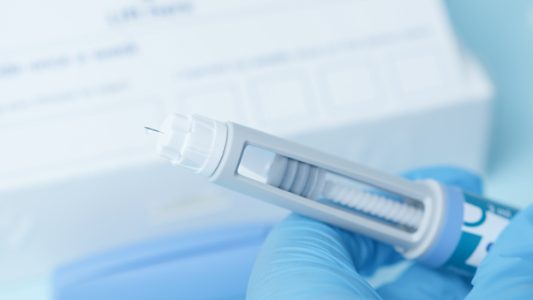

Decompensated Cirrhosis
- Approximately 12% of cirrhosis patients decompensate each year1
- Affects ~500K people in the United States1
- In the absence of liver transplant, median survival for those with decompensated cirrhosis and is about 2 years2

PHIN-214
Pharma IN is developing PHIN-214, an evolutionary vasopressor therapy in clinical trials for patients with advanced cirrhosis. It is a partial vasopressin V1a receptor agonist that can reduce portal hypertension. With a broad therapeutic index, PHIN-214 may offer improved safety and efficacy vs. existing vasopressor therapies. PHIN-214 is a subcutaneous self-injectable for application across healthcare settings which enables patients to manage their advanced cirrhosis effectively and independently.
How does it Work?
In decompensated cirrhosis, the liver is severely scarred, leading to poor blood flow and complications like low blood pressure and kidney dysfunction. One major issue is hemodynamic dysfunction where blood vessels in the abdomen become too relaxed, causing blood to pool around abdominal organs instead of circulating properly. This can worsen problems like hepatorenal syndrome (an acute and life-threatening type of kidney failure) and fluid buildup in the belly (ascites).
The Vasopressin/V1a axis is a clinically validated pathway to address hemodynamic dysfunction. V1a receptor agonists stimulate V1a receptors on abdominal smooth muscle causing vasoconstriction and redirecting pooled blood back into the general circulation. This increases systemic blood pressure and improves blood supply to the kidneys. By inducing vasoconstriction and improved circulatory function, PHIN-214 aims to reestablish hemodynamic balance, reduce fluid retention, and improve organ perfusion, addressing multiple complications of disease in patients with decompensated cirrhosis.
Publications & Presentations
AASLD25 Poster Presentation: Phase 1, Single-Ascending Dose Results from the PHIN-001® Study of PHIN-214 in Compensated and Decompensated Patients with Cirrhosis.
Douglas A. Simonetto, Naim Alkhouri, Ethan Weinberg, Christina C. Lindenmeyer, Gary Reiss, Eric Lawitz
D. Simonetto, N. Alkhouri, E. Weinberg, P. Schwabl, A. Kohli, M. Porayko, E. Lawitz.
Biomedicine & Pharmacotherapy: Subcutaneous therapy for portal hypertension: PHIN-214, a partial vasopressin receptor 1A agonist
Gerardo M. Castillo, Yao Yao, Rebecca E. Guerra, Han Jiang, Akiko Nishimoto-Ashfield, Alexander V. Lyubimov, Joshua F. Alfaro, Kali A. Striker, Nikolay Buynova, Philipp Schwabl, Elijah M. Bolotin.
Vasopressin V1a Publications
Mitsuhiro Yoshimura, Becky Conway-Campbell, Yoichi Ueta
Physiological Reviews: Vasopressin V1a and V1b receptors: From molecules to physiological systems
Taka-aki Koshimizu, Kazuaki Nakamura, Nobuaki Egashira, Masami Hiroyama,Hiroshi Nonoguchi, and Akito Tanoue
P. C. A. Kam, S. Williams and F. F. Y. Yoong
Sources:
- GBD 2017 Cirrhosis Collaborators, Lancet Gastroenterol Hepatol (2020) Mar; 5(3);
- Tapper, E.B., et al., JAMA (2023)329; pp 1589-1602
